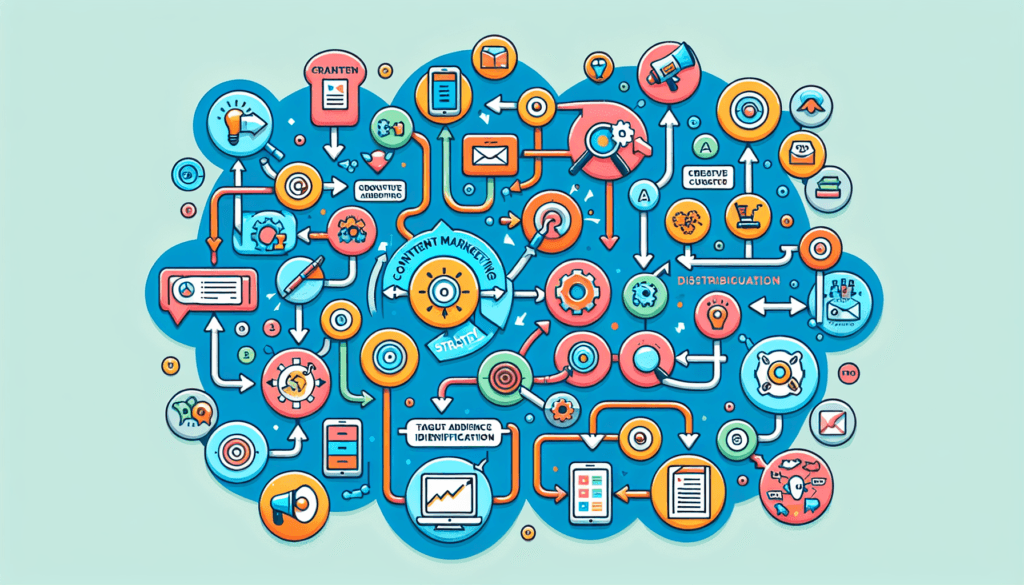Top Strategies for Successful Content Marketing for Small Business

Content marketing can help your small business attract more customers and build stronger relationships. But how can you make it work for your business? This article covers top strategies for successful Content Marketing for Small Business. You’ll learn how to identify your target audience, create engaging content, and promote it effectively.
Table of Contents
Key Takeaways
Consistent, high-quality content that focuses on storytelling can help small businesses build brand loyalty and trust with their audience.
Understanding the target audience is crucial; creating buyer personas and tracking engagement metrics can tailor content effectively.
Utilizing a diverse content strategy across various platforms, including social media and email marketing, enhances reach and engagement while collaborating with influencers can expand audience access.

Introduction
Content marketing is a strategic approach focused on creating and distributing valuable, relevant content to attract and engage a clearly defined audience. For small businesses, this approach not only increases brand awareness but also fosters customer relationships and enhances overall business growth. Creating content that addresses audience pain points and offers helpful insights through blog articles can drive traffic and convert visitors into loyal customers.
Unlike traditional advertising methods, content marketing allows small businesses to build trust and authority within their industry. Consistently publishing high-quality blog content helps small businesses position themselves as thought leaders and gain a competitive edge. Moreover, relevant content that answers common customer questions or provides solutions to their problems can significantly improve search engine rankings, driving organic traffic to the business’s website.
In this blog post, we will explore various strategies and techniques that small business owners can use to maximize the impact of their content marketing efforts. You’ll find valuable tips and actionable advice on identifying the target audience, leveraging social media channels, and repurposing content to create a successful content marketing strategy.
Understanding Content Marketing
Quality content attracts and retains audiences and encouraging readers to return. Informative and accurate content builds trust, ensuring the audience leaves knowing more about the topic. Creating quality content helps maintain content integrity through fact-checking and original insights, helping avoid pitfalls like misinformation and duplicate content.
Content marketing is not just about writing content; it’s about telling a story and engaging your audience. Avoiding jargon and focusing on relatable storytelling can maximize reader engagement. Consistency in publishing content is key to seeing long-term results, requiring careful planning and a clear strategy. A well-defined content strategy serves as a roadmap for effectively developing and distributing media assets to reach target audiences.
Small businesses should promote content through various platforms like social media channels, newsletters, and community outreach. Collaborating with local relevance through partnerships can further increase authority and audience engagement. Outsourcing content creation can provide small business owners with expert support, allowing them to focus on other essential business activities.
Benefits of Content Marketing for Small Businesses

Content marketing can significantly enhance a small business’s brand awareness and reputation as an industry leader. Relevant content improves a small business’s search engine visibility, aiding potential customers in discovering their services. Effective content marketing generates three times more leads per dollar spent than traditional marketing methods. Educating their audience fosters trust and recognition, essential for long-term customer relationships.
Small business content marketing efforts should focus on creating valuable content that addresses the needs and interests of their target audience. High-quality content not only attracts new customers but also keeps existing customers engaged, leading to increased brand loyalty and repeat business.
Consistent publication of valuable content helps small businesses establish themselves as trusted sources of information and solutions.
Identifying Your Target Audience
A target audience consists of individuals most likely to show interest in a company’s products or services, defined by shared characteristics. A successful content marketing strategy requires a deep understanding of the target audience. Content that addresses user experience and pain points boosts customer connection and engagement. To understand your target audience online, track metrics such as topic, format, platform, and active times of day.
Market research is essential for identifying the target market. Examining competitors’ target audiences can uncover market gaps and potential customer segments. Platforms like Quora or Yahoo! Answers can provide insights into what your audience is interested in and what content resonates with them.
Learn more about Juggernaut and the work we do
Creating buyer personas helps visualize your target audience’s demographics, interests, and pain points, making it easier to tailor your content marketing strategy to their needs.
Creating a Content Marketing Strategy

Measurable goals are crucial for evaluating content marketing effectiveness. These goals help develop a meaningful strategy and understand success. A content calendar ensures consistent publication and aligns with business goals. An effective content strategy serves as a roadmap for developing and distributing media assets to reach target audiences.
A content marketing strategy should include a mix of content types to keep the audience engaged. This can include blog posts, social media posts, videos, and infographics. The strategy should also outline the key messages and themes that will be covered and the channels through which the content will be distributed. Regular review and adjustment of the content strategy based on performance metrics are crucial for ongoing success.
To maximize the impact of your content marketing efforts, it’s important to leverage user-generated content and engage with your audience across various social media channels. Encouraging customers to share experiences and creating resonant content helps build a loyal community and increase brand awareness.
Types of Content to Create
Video content has become one of the most engaging forms of online content that small businesses should utilize. Podcasts provide in-depth engagement, allowing listeners to absorb content passively while doing other activities. Infographics are 30 times more likely to be read than text-only articles. Good content for small businesses comes in a variety of formats, including blog posts, social media posts, videos, and infographics.
Creating diverse content helps cater to different audience preferences and keeps the content marketing program fresh and engaging. Combining various content types allows small businesses to reach a broader audience and provide valuable information in different formats, resonating with different market segments.
Blogging for Small Businesses

Blogging remains one of the most effective formats for content marketing, offering long-term SEO benefits. Consistent blogging enhances a small business’s online visibility and fosters community engagement. Establishing brand authority and addressing trends and customer inquiries through blogging can significantly boost a small business’s reputation and reach.
Quality, original content positions a brand as a thought leader and enhances customer trust. Selecting topics based on audience pain points can lead to higher engagement and readership. Evergreen content remains relevant over time, continually attracting readers and providing long-term value. Engaging storytelling in blog posts can enhance the relatability and memorability of the content.
Incorporating keywords into blog posts is crucial for improving discoverability in search engine results. Proper content promotion is critical, as publishing without promotion can lead to low visibility. Promoting blog posts on social media channels increases traffic and strengthens audience relationships. Email marketing can also effectively highlight blog content, driving targeted visits to the website.
Leveraging Social Media Channels
Social media can significantly enhance content distribution and drive traffic to websites across various platforms. Each social media platform has unique features that should guide how content is tailored for its audience. Customizing content for different social media channels increases audience engagement. A content calendar helps maintain consistency in posting valuable social media content.
Engaging with the audience through responses and conversations boosts visibility and encourages sharing. Partnering with influencers helps businesses reach a broader audience and enhance visibility through established credibility. Content types such as links to blogs, newsletters, and videos can be effectively shared through social media posts.
Email Marketing and Newsletters
Email marketing is an essential part of a content marketing strategy for small businesses, sending content directly to subscribers. For every $1 spent on email marketing, the average return is $42. Building an email list enables businesses to own their subscriber data, which is more reliable than social media followers. An effective way to build an audience for content marketing is by regularly sharing content with the email list.
Effective email newsletters should include updates, blog links, product information, and event updates. Maintaining a consistent email sending schedule helps set expectations for subscribers.
Using email marketing software can help automate tasks, manage contacts, and analyze performance. Videos in email campaigns can increase click rates by 300%, enhancing engagement.
Repurposing Content
Repurposing content into various formats broadens reach and maximizes resource use. Transforming existing content into different formats and sharing it on various platforms keeps it fresh and engaging. Repurposing high-performing content for different mediums maximizes engagement. For example, a single blog post can be repurposed into a YouTube video, podcast, infographic, or eBook.
Repurposing content is essential for maximizing reach and engaging visitors without creating new content. Creating summaries of white papers or infographics from webinars are effective methods of content repurposing.
Ultimately, repurposing should add value to visitors and enhance their experience.
User-Generated Content

User-generated content can enhance trust and engagement by showcasing real customer experiences. Utilizing user-generated content can significantly enhance a small business’s online presence while keeping costs low. Sharing user-generated content fosters community engagement and strengthens customer relationships. Encouraging users to create content can be achieved through social media contests or by using branded hashtags.
Run giveaways offering bonus entries for user-generated content submissions. Consider sharing customer posts that tag the brand if they present the brand positively. Engaging with customer posts boosts brand visibility and incentivizes ongoing interaction and support.
Collaborating with Influencers and Local Businesses
Collaborating with influencers can expand content reach by tapping into their established audiences. Collaborative marketing can significantly reduce costs as partners share resources and marketing expenses. It provides opportunities for partnerships and co-marketing with related businesses. Collaborating with local businesses opens access to niche marketing channels appealing to specific communities.
Long-term partnerships in collaborative marketing can result in ongoing exposure and new revenue opportunities for involved businesses. Working with influencers and local businesses allows small businesses to leverage their credibility and reach to increase brand awareness and drive sales.
Measuring and Analyzing Results
Key metrics for evaluating content performance include:
Page views
Engagement rates
Conversion rates
Social shares
Measuring content success involves tracking metrics like unique page views and conversion rates, which should align with initial goals.
Effective content analytics can lead to increased engagement and improved campaign strategies. Understanding customer behavior through analytics refines content strategies to enhance user interaction.
Tools that can help track key metrics for content marketing include Google Analytics, social media platform tools, and other marketing tools. Regular performance checks assess the effectiveness of your content. Regular analysis of content performance helps tailor future content to better meet audience preferences.
A/B testing allows marketers to compare different content versions to determine which performs better.
Summary
In summary, content marketing for small businesses is a powerful tool that can enhance brand awareness, build customer trust, and drive sales. By understanding and implementing a well-thought-out content marketing strategy, small business owners can create quality content that resonates with their target audience. From identifying the right audience to leveraging user-generated content and collaborating with influencers, each step plays a crucial role in the overall success of the marketing efforts.
As we have explored, the key to successful content marketing lies in consistency, creativity, and engagement. By utilizing various types of content, promoting it across different channels, and regularly measuring and analyzing results, small businesses can stay ahead of the competition and continually improve their content marketing strategies. Start implementing these strategies today and watch your business grow!
Frequently Asked Questions
What is the first step in creating a content marketing strategy for a small business?
The first step in creating a content marketing strategy for a small business is to set measurable goals that align with your business objectives. This foundational approach ensures that your strategy is purposeful and allows for effective tracking of success.
How can small businesses identify their target audience?
To effectively identify their target audience, small businesses should conduct market research, analyze competitors, and develop buyer personas that capture the demographics, interests, and challenges of their ideal customers. This approach ensures a clear focus on the audience that will drive their success.
What types of content should small businesses focus on creating?
Small businesses should prioritize a diverse range of content, including blog posts, videos, podcasts, infographics, and social media posts, to effectively engage various audience segments. This approach enhances visibility and fosters meaningful connections with potential customers.
How can user-generated content benefit small businesses?
User-generated content boosts trust and engagement for small businesses by highlighting authentic customer experiences, which fosters community involvement. It effectively enhances online presence while keeping marketing costs low.
What tools can help measure the effectiveness of content marketing efforts?
Utilizing tools such as Google Analytics and social media analytics can significantly enhance your ability to measure content marketing effectiveness by tracking essential metrics like engagement rates and conversion rates, guiding you to refine your strategies effectively.
